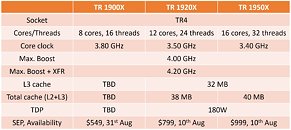- Joined
- Oct 9, 2007
- Messages
- 47,675 (7.43/day)
- Location
- Dublin, Ireland
| System Name | RBMK-1000 |
|---|---|
| Processor | AMD Ryzen 7 5700G |
| Motherboard | Gigabyte B550 AORUS Elite V2 |
| Cooling | DeepCool Gammax L240 V2 |
| Memory | 2x 16GB DDR4-3200 |
| Video Card(s) | Galax RTX 4070 Ti EX |
| Storage | Samsung 990 1TB |
| Display(s) | BenQ 1440p 60 Hz 27-inch |
| Case | Corsair Carbide 100R |
| Audio Device(s) | ASUS SupremeFX S1220A |
| Power Supply | Cooler Master MWE Gold 650W |
| Mouse | ASUS ROG Strix Impact |
| Keyboard | Gamdias Hermes E2 |
| Software | Windows 11 Pro |
AMD maybe have shaken up the HEDT (high-end desktop) processor market with three Ryzen Threadripper SKU announcements early this week; but the two specifications that eluded us were their rated TDP and cache amounts. The first Ryzen Threadripper models will be available in the market from the 10th of August, and will include the 12-core/24-thread 1920X and the flagship 16-core/32-thread 1950X. Both models will feature the full 32 MB of L3 cache available from a pair of 14 nm "Summit Ridge" dies, which work out to "total cache" (L2+L3) amounts of 38 MB for the 1920X and 40 MB for the 1950X. The TDP of the 1920X and 1950X is rated at 180W. The TDP and cache configuration of the 8-core/16-thread 1900X remains unknown, for now.

View at TechPowerUp Main Site

View at TechPowerUp Main Site







